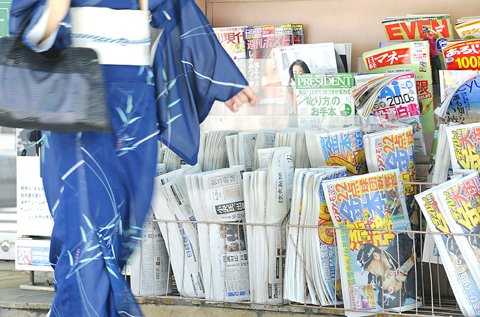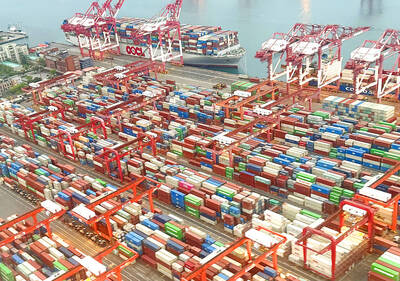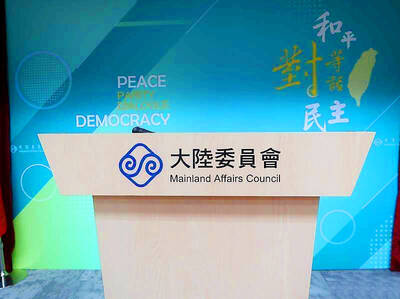With huge circulations, loyal readers and a tireless reporting culture that runs around the clock, Japan’s newspapers have defied many of the woes that have beset their Western print peers. But a crisis of shrinking revenues is looming as Japan’s dailies scramble to make their online editions profitable, attract a new generation of readers in an ageing society and avoid the woes of US and European titles.
Advertising spending has plunged 42 percent in the past decade, exacerbated by a global downturn that hammered the Japanese economy, threatening to make negative headlines out of print media’s bottom lines.
“Newspapers are seeing a crisis coming,” Shinji Oi, a professor at Nihon University said. “Japan has yet to see the major newspaper bankruptcies and financial troubles that we have seen in the West. But newspapers’ business fundamentals are definitely deteriorating.”

PHOTO: AFP
The Japanese newspaper industry has seen circulation slip only 6 percent in the 10 years to last year, with the top-selling Yomiuri Shimbun boasting the world’s biggest of more than 10 million copies daily.
And newspapers remain the preferred source of news in Japan, with circulation standing at a robust 50.4 million daily sales last year, according to the Japan Newspaper Publishers & Editors Association. Advertising revenue, which can be volatile particularly during slow economic times, accounts for roughly 30 percent of their income.
But an apparent failure to capture a younger generation that grew up with the Internet and the concept of free, up-to-the-minute news could prove costly in a graying society. People in their 20s generally view newspapers as an expensive and time-consuming media that includes unnecessary information and can be replaced by free alternatives, according to think tank M1F1 Research Institute.
A separate survey by the Japan Press Research Institute found that most people under 40 regarded an average US$40 monthly newspaper subscription fee as too expensive.
Meanwhile, a perceived deterioration of quality in pursuit of sensationalism has disappointed readers, said Takaaki Hattori, media law professor at Rikkyo University.
Serious journalism was costly and Japanese media had sought to cut editorial spending at the expense of quality reporting, Hattori said.
He added that a crisis that saw “two or three major papers folding” would actually be a good thing for an industry veering towards complacency.
“Then, the industry may find ways to rebuild itself,” he said.
Such a process is underway in the US, where a reliance on ailing advertising revenues sounded the death knell for many titles as the global economy soured. The Tribune Co, the owner of the Los Angeles Times and other papers, filed for bankruptcy protection in December 2008, a status it is currently working to exit from. But in July, The Times Co, which owns the New York Times, among others, reported double-digit growth in digital advertising to offset a continued slide in print advertising.
Yet major Japanese media have shied away from establishing full-blown Internet editions as they have failed to profit from such ventures due to reader resistance to pay for news amid falling advertising revenues.
The Japanese language also limits the international market value of their sites, unlike US and British media that can serve English speakers around the world, analysts say.
Gadgets such as the iPhone and iPad have encouraged the wider public to read news for free, with consumer spending soft in the wake of Japan’s protracted economic slowdown since the early 1990s. Domestic news media have taken a wait-and-see approach to devices such as the iPad when it comes to tailoring applications for the Japanese market, but now titles such as the Nikkei Shimbun and the Sankei Shimbun have launched apps.
At the vanguard is the Nikkei business daily, which became the first major Japanese paper to launch a full-scale online edition, featuring free and paid-content sections with stories and analysis.
Since its launch in late March, the online Nikkei has acquired about 440,000 subscribers, including some 70,000 paid readers by July. However, that is only a tiny fraction of the paper edition’s 3 million circulation.
“We think it will be difficult to go with the paper edition alone,” said Kiyoshi Noma, deputy managing director of the Nikkei’s online business.
“With the Web edition co-existing with the printed edition, we may be able to create a new business model,” he said, adding that readers are willing to pay for quality information — online or not.

MORE VISITORS: The Tourism Administration said that it is seeing positive prospects in its efforts to expand the tourism market in North America and Europe Taiwan has been ranked as the cheapest place in the world to travel to this year, based on a list recommended by NerdWallet. The San Francisco-based personal finance company said that Taiwan topped the list of 16 nations it chose for budget travelers because US tourists do not need visas and travelers can easily have a good meal for less than US$10. A bus ride in Taipei costs just under US$0.50, while subway rides start at US$0.60, the firm said, adding that public transportation in Taiwan is easy to navigate. The firm also called Taiwan a “food lover’s paradise,” citing inexpensive breakfast stalls

TRADE: A mandatory declaration of origin for manufactured goods bound for the US is to take effect on May 7 to block China from exploiting Taiwan’s trade channels All products manufactured in Taiwan and exported to the US must include a signed declaration of origin starting on May 7, the Bureau of Foreign Trade announced yesterday. US President Donald Trump on April 2 imposed a 32 percent tariff on imports from Taiwan, but one week later announced a 90-day pause on its implementation. However, a universal 10 percent tariff was immediately applied to most imports from around the world. On April 12, the Trump administration further exempted computers, smartphones and semiconductors from the new tariffs. In response, President William Lai’s (賴清德) administration has introduced a series of countermeasures to support affected

CROSS-STRAIT: The vast majority of Taiwanese support maintaining the ‘status quo,’ while concern is rising about Beijing’s influence operations More than eight out of 10 Taiwanese reject Beijing’s “one country, two systems” framework for cross-strait relations, according to a survey released by the Mainland Affairs Council (MAC) on Thursday. The MAC’s latest quarterly survey found that 84.4 percent of respondents opposed Beijing’s “one country, two systems” formula for handling cross-strait relations — a figure consistent with past polling. Over the past three years, opposition to the framework has remained high, ranging from a low of 83.6 percent in April 2023 to a peak of 89.6 percent in April last year. In the most recent poll, 82.5 percent also rejected China’s

PLUGGING HOLES: The amendments would bring the legislation in line with systems found in other countries such as Japan and the US, Legislator Chen Kuan-ting said Democratic Progressive Party (DPP) Legislator Chen Kuan-ting (陳冠廷) has proposed amending national security legislation amid a spate of espionage cases. Potential gaps in security vetting procedures for personnel with access to sensitive information prompted him to propose the amendments, which would introduce changes to Article 14 of the Classified National Security Information Protection Act (國家機密保護法), Chen said yesterday. The proposal, which aims to enhance interagency vetting procedures and reduce the risk of classified information leaks, would establish a comprehensive security clearance system in Taiwan, he said. The amendment would require character and loyalty checks for civil servants and intelligence personnel prior to